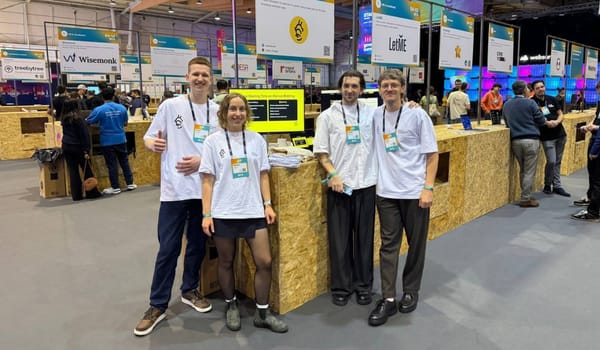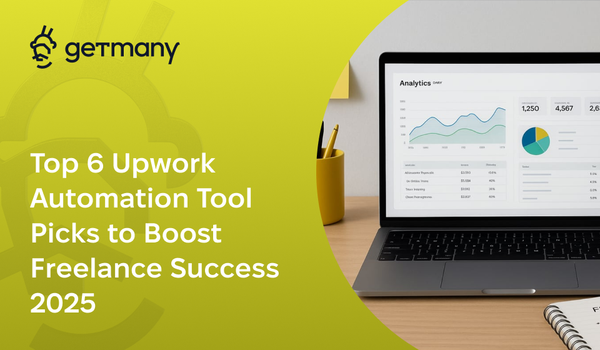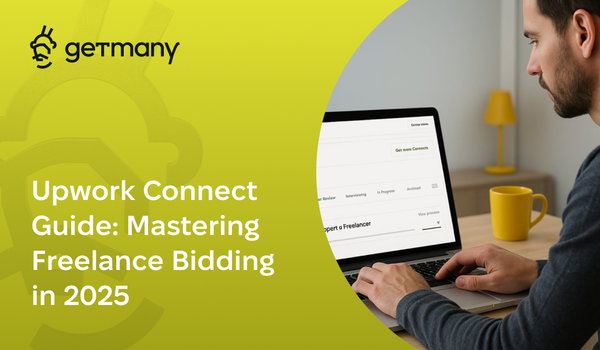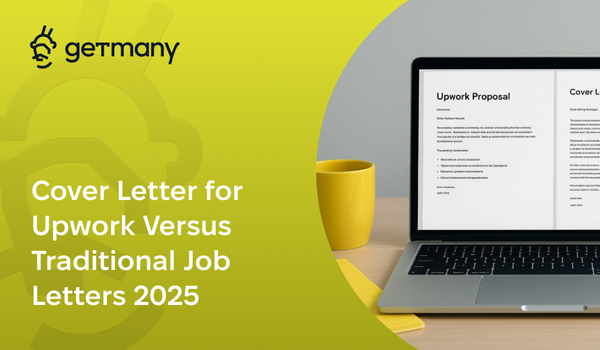From Freelancer to Agency: Making the Transition on Upwork
Transform from trading time for money to building scalable systems. The complete roadmap from solo freelancer to thriving agency owner on Upwork.
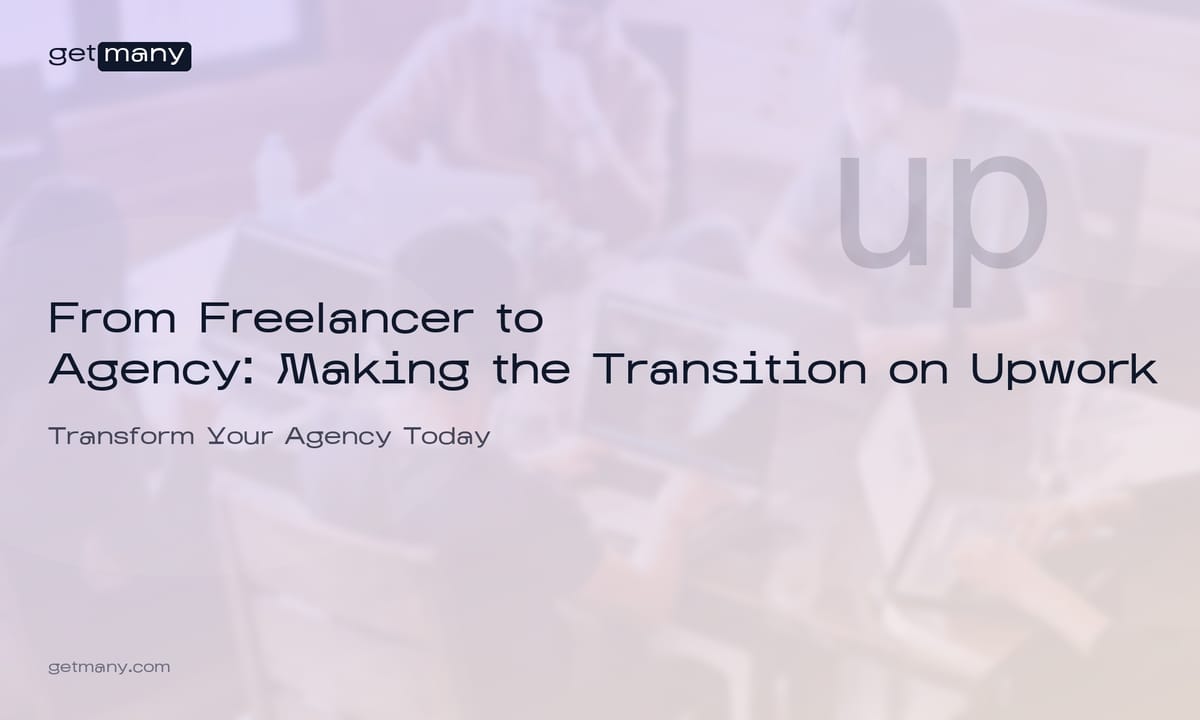
Three years ago, I hit the freelancer ceiling - working 70-hour weeks, turning down lucrative projects, and watching my health deteriorate while my income plateaued. The breaking point came when I calculated that despite earning $120K annually, my effective hourly rate after all the unpaid admin work was just $38. That's when I decided to transition from freelancer to agency owner.
Within 18 months, that decision transformed my business from a job that owned me into an asset that worked for me. Revenue grew to $450K, I worked 30 hours per week, and most importantly, I built something sellable rather than just trading time for money.
The transition from freelancer to agency is the most important evolution in your Upwork journey. This guide provides the complete roadmap, including mindset shifts, practical steps, and proven strategies to make your transformation successful and sustainable.
The Freelancer's Dilemma: Why Transition?
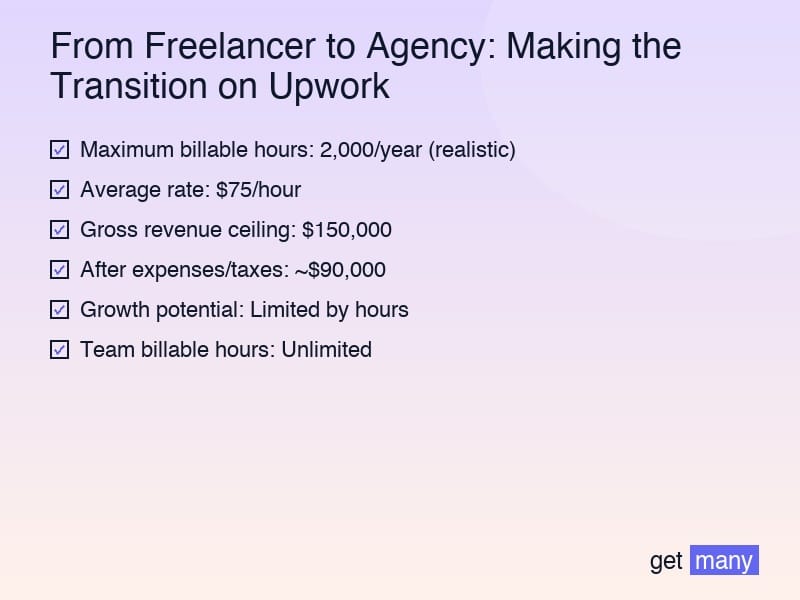
Before diving into how, let's clarify why this transition is critical:
The Income Ceiling Reality
Freelancer Math:
- Maximum billable hours: 2,000/year (realistic)
- Average rate: $75/hour
- Gross revenue ceiling: $150,000
- After expenses/taxes: ~$90,000
- Growth potential: Limited by hours
Agency Math:
- Team billable hours: Unlimited
- Average rate: $125/hour
- Revenue potential: $1M-10M+
- Profit margins: 20-40%
- Growth potential: Exponential
The Hidden Costs of Freelancing
Beyond income limitations, consider:
Time Poverty:
- No real vacations (income stops)
- Constant hustle for next project
- Weekend work normalized
- Burnout inevitable
Business Fragility:
- You get sick = business stops
- No systems or processes
- Client dependency high
- Nothing to sell eventually
Growth Impossibility:
- Can't take larger projects
- Miss enterprise opportunities
- No competitive advantage
- Limited market positioning
The Mindset Transformation Required
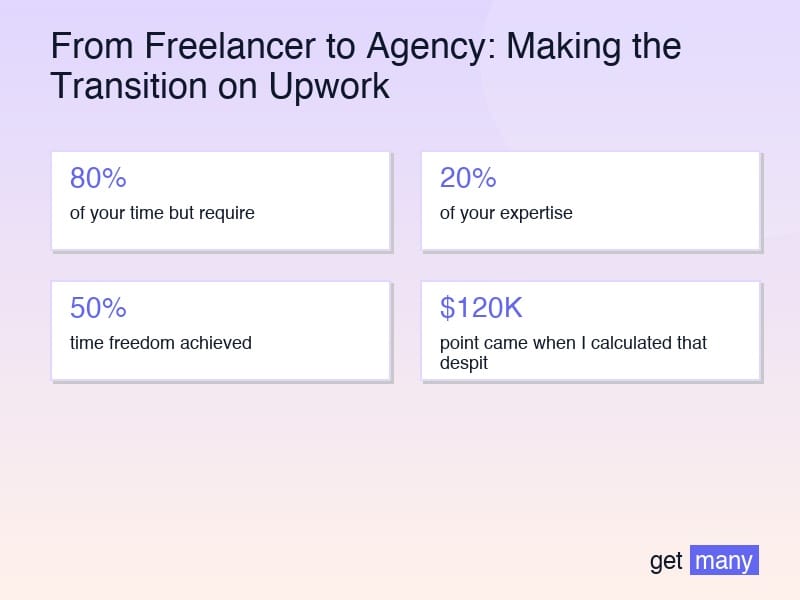
The biggest barrier isn't tactical - it's psychological:
From Craftsperson to CEO
Freelancer Mindset:
- "I do great work"
- "Clients hire me for my skills"
- "I need to be involved in everything"
- "My time equals money"
- "Quality requires my touch"
Agency Owner Mindset:
- "We deliver great outcomes"
- "Clients hire us for results"
- "I build systems and lead people"
- "Value creation equals money"
- "Quality comes from processes"
The Identity Shift
This transition requires letting go of your identity as the person who does the work and embracing your role as the person who ensures work gets done excellently.
Common Identity Blocks:
- "Nobody can do it like me"
- "Clients want me specifically"
- "I'll lose quality control"
- "It's easier to do it myself"
- "I don't trust others"
Reality Checks:
- You're not irreplaceable (harsh but true)
- Clients want outcomes, not you
- Systems ensure quality, not individuals
- Short-term pain, long-term gain
- Trust is built, not assumed
The 5-Phase Transition Framework
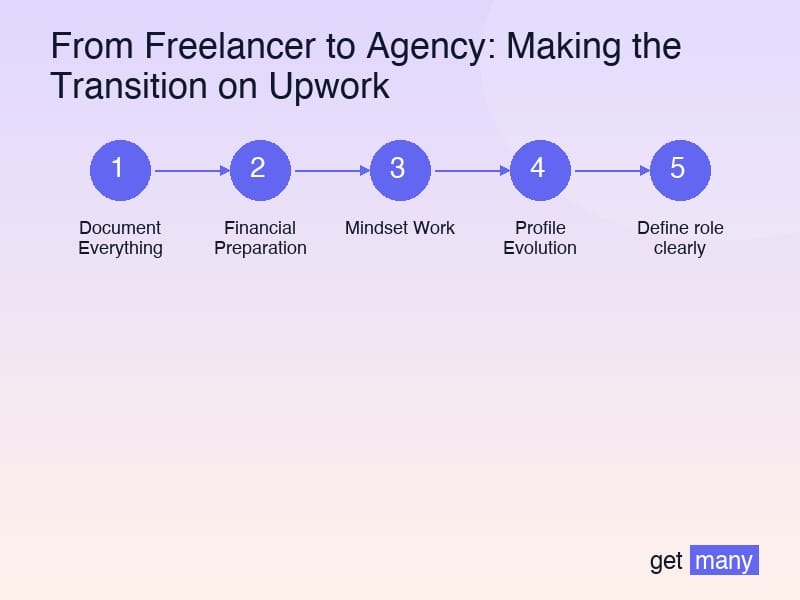
Phase 1: Foundation (Months 1-3)
Objective: Prepare for growth while maintaining current income
Key Actions:
- Document Everything
- Record yourself doing tasks
- Create process documents
- Build template library
- Systematize delivery
- Financial Preparation
- Save 6 months expenses
- Separate business finances
- Set up legal structure
- Plan investment budget
- Mindset Work
- Read "E-Myth Revisited"
- Join agency owner groups
- Find mentor/coach
- Visualize future state
- Profile Evolution
- Shift from "I" to "We" language
- Add team capacity mentions
- Update portfolio focus
- Adjust positioning
Success Metrics:
- 20+ processes documented
- 6 months savings secured
- Legal structure established
- Profile updated
Phase 2: First Hire (Months 4-6)
Objective: Make first successful hire while maintaining quality
The 80/20 Hire Strategy: Identify tasks that take 80% of your time but require 20% of your expertise.
Common First Hires:
- Junior developer (for senior devs)
- Content writer (for strategists)
- Designer (for developers)
- VA (for everyone)
Hiring Process:
- Define role clearly
- Create test project
- Hire 2-3 for trial
- Select best performer
- Invest in training
Delegation Framework:
- Week 1-2: Shadow and observe
- Week 3-4: Guided practice
- Week 5-6: Supervised independence
- Week 7-8: Full delegation
Success Metrics:
- First hire profitable
- 20+ hours/week freed
- Quality maintained
- Systems improving
Phase 3: Service Expansion (Months 7-9)
Objective: Expand capabilities and increase project values
Strategic Expansion Options:
Vertical Expansion (Deeper):
- Add complementary services
- Increase project scope
- Offer full solutions
- Build recurring revenue
Horizontal Expansion (Wider):
- Add adjacent services
- Serve new industries
- Different project types
- New delivery models
Team Structure Evolution: ``` You (CEO/Sales) ↓ Lead Specialist → Junior Specialist ↓ Support Role ```
New Service Introduction:
- Validate with existing clients
- Hire specialized talent
- Create service packages
- Test with small projects
- Scale based on success
Success Metrics:
- 2-3 team members
- Average project value +50%
- Service packages defined
- Revenue growing 20%+ monthly
Phase 4: Systems Scale (Months 10-12)
Objective: Build scalable operations beyond founder dependency
Critical Systems to Build:
1. Sales System
- Lead qualification process
- Proposal templates
- Pricing frameworks
- CRM implementation
2. Delivery System
- Project management tools
- Quality control processes
- Client communication standards
- Team collaboration protocols
3. Financial System
- Automated invoicing
- Expense tracking
- Profitability analysis
- Cash flow management
4. People System
- Hiring processes
- Training programs
- Performance standards
- Growth pathways
Management Layer Introduction: Consider first management hire when team exceeds 5 people.
Success Metrics:
- 5+ team members
- $50K+ monthly revenue
- 50% time freedom achieved
- Systems running smoothly
Phase 5: True Agency (Months 13+)
Objective: Build sustainable agency that runs without you
Agency Maturity Markers:
- Team handles all delivery
- You focus on strategy/growth
- Predictable revenue
- Strong profit margins
- Sellable asset
CEO Focus Areas:
- Vision and strategy
- Key client relationships
- Team development
- Business development
- System optimization
Advanced Strategies:
- Develop proprietary methods
- Build strategic partnerships
- Create recurring revenue
- Explore acquisition opportunities
- Plan exit strategy
Navigating Common Transition Challenges
Challenge 1: Client Resistance
Problem: "We hired you, not a team"
Solutions:
- Gradual team introduction
- Maintain face relationship
- Over-deliver during transition
- Frame as capacity expansion
- Highlight team benefits
Script: "I'm expanding capacity to serve you better. You'll still work directly with me on strategy, while my certified team handles execution to my standards."
Challenge 2: Quality Concerns
Problem: Work quality drops with delegation
Solutions:
- Robust training systems
- Quality control processes
- Regular audits
- Client feedback loops
- Continuous improvement
Framework:
- Define quality standards
- Create checking systems
- Implement feedback loops
- Iterate based on data
- Celebrate improvements
Challenge 3: Financial Pressure
Problem: Increased costs before increased revenue
Solutions:
- Start with contractors
- Phase hiring slowly
- Focus on profitable work
- Cut non-essential costs
- Maintain savings buffer
Financial Staging:
- Months 1-3: Investment phase (-10% margins)
- Months 4-6: Break-even phase (0-10% margins)
- Months 7-9: Profit phase (10-20% margins)
- Months 10+: Scale phase (20-30% margins)
Challenge 4: Management Overwhelm
Problem: Managing people is hard
Solutions:
- Start with self-managers
- Implement clear systems
- Regular 1:1 meetings
- Document everything
- Invest in management training
Daily Management Routine:
- Morning: Team check-in (15 min)
- Midday: Progress review (30 min)
- Evening: Next-day planning (15 min)
- Weekly: 1:1 meetings (30 min each)
The Transition Timeline Visualized
Months 1-3: Foundation
- Revenue: $10-15K (solo)
- Time: 50-60 hours/week
- Focus: Documentation
Months 4-6: First Hire
- Revenue: $15-20K
- Time: 40-50 hours/week
- Focus: Delegation
Months 7-9: Expansion
- Revenue: $25-35K
- Time: 35-45 hours/week
- Focus: Growth
Months 10-12: Scale
- Revenue: $40-60K
- Time: 30-40 hours/week
- Focus: Systems
Year 2+: Agency
- Revenue: $75K+
- Time: 20-30 hours/week
- Focus: Strategy
Your 90-Day Quick Start Plan
Days 1-30: Preparation Sprint
- Document 5 core processes
- Save $10K minimum
- Register LLC/legal structure
- Update Upwork profile
- Define first hire role
Days 31-60: Hiring Phase
- Post first job
- Interview candidates
- Run test projects
- Make first hire
- Begin training
Days 61-90: Optimization
- Delegate first tasks
- Refine processes
- Gather feedback
- Plan expansion
- Celebrate progress
The Agency Owner's Promise
Making this transition isn't just about money - it's about freedom, impact, and building something meaningful. Yes, it's challenging. Yes, you'll make mistakes. But the rewards far exceed the risks.
What Awaits You:
- Time freedom to focus on what matters
- Income potential beyond solo limits
- Business asset you can sell
- Impact at scale
- True entrepreneurship
Your immediate action steps:
- Commit to the transition - decide this is your path
- Document one process today - start building systems
- Calculate your numbers - know your financial runway
- Find your first hire candidate - start looking now
- Join an agency community - don't do this alone
Remember: every successful agency owner was once a freelancer who decided to think bigger. The only difference between them and you is they took action.
Ready to stop trading time for money and start building a real business? The roadmap is clear. The opportunity is massive. The time is now.
What's the first step you'll take toward agency ownership today?


